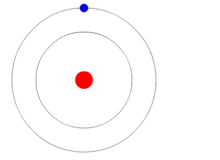|
There are about 118 elements and 16 elementary particles and four forces from which everything is made. At one time there were thought to be only 4 elements but that was before people started looking. Each of these elements is composed of atoms in various arrangements. It seems that every time a new particle collider is fired up, more particles appear. This makes one wonder, "what's a particle?"
In this case, there is no force needed to explain why these atoms hold together, since plain old inertia will account for their stability. To upset this state you have to introduce something from the outside. This is generally what is called a particle with high energy but it's only a particle in the sense of having high energy in a small space. For this energy to affect an atom it has to have a wavelength less than the size of the atom which, for all practical purposes, behaves as if it is a particle. This may be significant. If energy is focused into a small enough space, it is, effectively, the same as a particle. This makes the idea of "particle" merely a description for some region of space with high energy; there is no such "thing" as a particle. Thinking in terms of particles is just an explanatory convenience.
There is probably no difference in how we work with atoms, but the above does radically simplify how we understand them. Since there are no forces at work holding an atom together, all we need to know is the force (energy) it takes to split it apart. This same simplification applies to the "particles" within an atom. A proton, for instance, isn't a “thing” but the force required to affect its position. Particle accelerators can strip an atom of its electrons and isolate protons that can then be made to collide with other atom or protons. From these collisions, physicists can produce sub-proton particles. Collisions at the same energy level will produce the same particles. Increasing the energy produces different particles. This is a clue. What's being observed are the results of different energies interacting; no particles are necessary to explain any of this. Particles are focused energy. |
Go to the Contents Page


